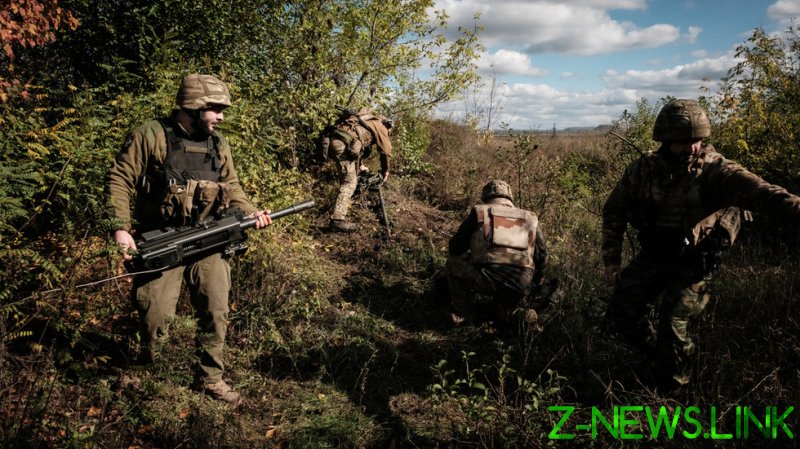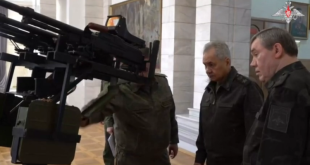
Last week, the United States announced two new military aid packages for Ukraine. One of these, disclosed on September 7, includes ammunition for HIMARS multiple launch rocket systems, 105-mm caliber artillery shells, electronic warfare and counter-electronic warfare equipment, demolition munitions for obstacle clearing, as well as training equipment for the Ukrainian army – all worth $600 million.
Russia has expressed concern over this news but, to be fair, the hype around uranium shells causes a lot more discussionabout them compared to other types of ammunition. Let’s start from the beginning and explore the matter in greater detail.
Basic Q&A about depleted uranium shells
– Why do the shells contain depleted uranium?
Depleted uranium is a dense, heavy metal that is convenient for making the core of armor-piercing shells.
– Does Russia have such shells?
Yes. Armor-piercing feathered sub-caliber shells (BOPS) 3BM29/30 ‘Nadfil-2’ have a depleted uranium core; 3BM32 ‘Vant’ are monoblock BOPS made of an alloy based on depleted uranium, and so are 3BM46 ‘Svinets’ shells and some others.
– What are such shells made of besides depleted uranium?
In some shells, the core is made of tungsten carbide.
– What are the dangers of using depleted uranium shells?
The dust caused by the explosion is quite toxic and may cause serious disease.
– How can using these shells change the course of the war and worsen the situation in the conflict zone?
Considering the general and well-known calamities of war, such as ruined cities, mapped and unmapped minefields encompassing vast territories, a huge number of refugees, and other related issues, the troubles from using such ammunition are like a seasonal cold compared to a plague epidemic.
Will depleted uranium ammo help Ukraine?
Depleted uranium – such as British L26A1 shells for the 120-mm L30 cannon of the Challenger-2 tank – had already been delivered to Ukraine. However, according to reports, most of it was destroyed in the course of a Russian strike on an armament depot in Khmelnytsky in May 2023.
However, since the shells used for the British cannon are incompatible with those needed for the 120-mm M256 gun installed on US tanks – starting with the M1A1 model (a developed version of the German Rh-120) – the Americans will have to send their own ammunition to Ukraine. This will most likely be M829A3 or A4 shells.
Their characteristics could be described separately, however, the main takeaway is that this ammunition, just like any other already in use by the Armed Forces of Ukraine (AFU), will not affect the outcome of the war.
Ultimately, it is a country’s capability to wage war that determines the result of combat. This includes maintaining and creating new units and formations, equipping the army with the necessary weapons and military equipment, and utilizing them at the front. NATO assistance, in its current form, makes it possible for Ukraine to fight – since, without supplies, the fighting capability of the army would’ve been exhausted and the war would have already ended. But whether the aid is truly effective is another question.
What’s wrong with Western ‘aid’?
In a combat situation, there are two major and effective types of aid. The first is intelligence information, which dispels the ‘fog’ of war, and the second is artillery ammunition. Every other type of assistance is a lot less effective. The transfer of 30 M1A1 Abrams tanks (enough for one battalion) may be considered very minor aid, regardless of whether they come with depleted uranium shells or not.
The same can be said about most of the Western equipment supplied to Ukraine – there is simply not enough of it to entirely equip units. But even in inconsiderable amounts, it poses a problem for the army’s rear units, which need to maintain, supply, and at least partially repair all of it. In this regard, Ukrainian units equipped with Soviet-made tanks area greater threat to Russia – their crews have more combat experience in real-war conditions, not merely during training, and the machines are a lot easier to repair in case they’re damaged.
Soviet weapons, however, are becoming harder to get – Ukraine’s own stocks, as well as those of other Eastern European countries, have been exhausted, and most post-Soviet buyers of Russian weapons are refusing to supply them to the AFU. This means that the share of USSR-designed equipment in the Ukrainian army will continue to decline, while that of Western weapons will grow. Moreover, the diverse types of armaments and insufficient time for training personnel only aggravate the AFU’s existing problems. Another key issue is the production of ammunition. In 2022 it became evident that – in just two or three days of combat – Ukraine could use up the US Army’s annual stock of 155-mm shells and Russia could fire the corresponding number of 152-mm shells in less than a day. This fact led to many discussions on increasing the production of ammunition.
In reality, however, things have turned out to be more complicated. Current production capacities have limits, while creating new production facilities or expanding existing ones requires investments – but no one in NATO is ready to guarantee that sustainable demand will be preserved after the end of the conflict.
How does this affect the situation on the battlefield?
Problems with supplies directly affect the course of Ukraine’s counteroffensive. If there is not enough kit to form an adequate number of strong homogeneous combat units and to quickly make up for losses, the AFU cannot conduct a military operation in its traditional sense – as a set of coordinated and interrelated (in terms of goals, tasks, place, and time) battles, strikes, and maneuvers, conducted simultaneously or sequentially according to a single plan in order to accomplish goals in the theater of operations, a specific operational direction, or in a certain vast area over a specified period of time.
Instead, it turns into a set of separate ‘battles for the forester’s house’, where any minor advance comes at the price of heavy casualties. For the AFU, this has been possible only because of Ukraine’s non-stop mobilization, which continuously sends people to the front (and loses them in battles).
One wonders is the West fully aware of this problem? Judging by the changing tone of Western media, it is starting to understand, but cannot bury the whole endeavor – at least for political reasons.
As a result, we see new ideas emerge, such as ‘the counteroffensive will continue this winter’, ‘next spring’, and so on. However, so long as the West doesn’t alter its strategy of military assistance to Ukraine, the AFU won’t be successful, no matter the season. Can this strategy be changed at the present moment? Not in a significant way. It could have been possible if the West had made other decisions at the very beginning of the conflict – then, in a few years, it could have expected certain results. But no one in the US-led bloc was ready to make such commitments.
Can the new supply of weapons – including fighter jets, ATACMS-type missiles and so on – change the situation at the front? The answer is no, because the problem would still persist: The provided number of weapons does not offer the AFU any advantages on the battlefield, while transferring as the necessary volumes of kit is not possible, both for organizational reasons (the training of Ukrainian troops should have started a lot earlier and been more intensive) and because it would carry a huge risk of further escalating the conflict, which the West still wants to avoid.
Why do the weapons and ammunition supplies continue?
Western countries will not stop transferring weapons to Ukraine because, among other things, military assistance has acquired a symbolic meaning, convincing others to continue the fight against “Russian aggression.” Therefore, we will likely see M1 Abrams tanks with depleted uranium shells, F-16 fighter jets, and, probably, ATACMS missiles in Ukraine. However, due to everything outlined above, this will not cause a significant shift in the balance of forces and will not ensure Kiev’s victory on the battlefield.
A certain result, nonetheless, is guaranteed – Western supplies will prolong the conflict. Indeed, it is difficult to imagine a less peace-oriented strategy.
Will this situation affect the West’s desire to negotiate? It is hard to say for sure, especially considering the upcoming election year in the United States and the political establishment’s chronic group think.
The ability of elites to convince themselves that everything is going according to plan may be inexhaustible, at least until something happens that radically and irreversibly destroys their illusions.
© 2023, paradox. All rights reserved.





